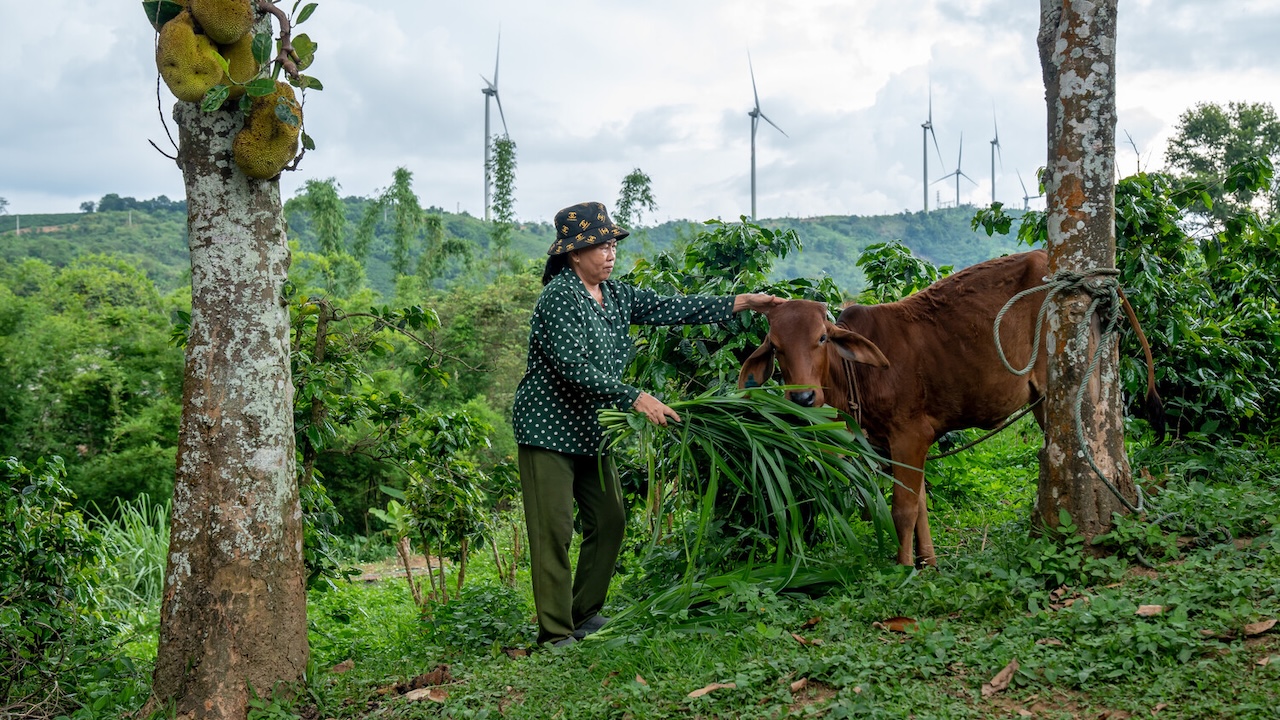How a Rural Wind Power Project Generates Not Just Electricity, but Also Stable Jobs and Hope

The project created jobs and improved livelihoods, bringing economic prosperity to local communities. Photo credit: ADB.
ADB’s impact analysis shows the project contributed $89.6 million to Viet Nam’s gross domestic product, signifying a substantial economic stimulus.
Ho Thi My Nhung has always wished for financial stability so she could send her children to school. Although her family runs a snack eatery, financial stability eluded the 32-year-old resident of Khe Sanh, Huong Hoa District, Quang Tri Province, Viet Nam, since her husband has an irregular job.
Nhung’s anxiety over her family’s finances eased in July 2022 when she was hired as full-time staff at the company operating the Lotus Wind Power Project, also in Huong Hoa, a mountainous rural district. “This job gives me and my family a sense of stability in our finances. As a woman, it gives me a bigger voice in the family’s decision making.”
The project is comprised of three wind farms with total capacity of 144 megawatts (MW). The wind farms—Lien Lap, Phong Huy, and Phong Nguyen (with 48 MW each)—were constructed and operated by the PC1 Group Joint Stock Company (PC1 Group) and RENOVA Global Business Development Company.
The wind farms were connected in September 2021 and started operating and delivering power to the national grid in October 2021.
Long dependent on fossil fuels to meet energy needs, Viet Nam has been actively transitioning toward cleaner and more sustainable sources of power. Based on 2022 data (Viet Nam Electricity 2022), renewables accounted for 48% of total power generation (130,000 gigawatt-hour) in Viet Nam, comprising mostly hydropower plants (35%) while wind, solar, and biomass accounted for 13%.
The Lotus Wind Power Project was the Asian Development Bank’s (ADB) first financing for a wind power initiative in Viet Nam. ADB arranged and syndicated a $173 million financing package for the project in 2021.
The project marks a significant advancement for the rapidly developing wind power industry in Viet Nam and was the first wind power project that not only ADB but all the other participating lenders have financed in the country.
Beyond clean energy
Beyond generating clean energy, the project benefited the local and national economy. According to ADB’s analysis of the project’s economic impacts, the project contributed $89.6 million to Viet Nam’s gross domestic product, signifying a substantial economic stimulus. ADB examined the project’s economic impacts using a methodology that calculates the project’s effect on employment, earnings, value‑added, and gross economic output.
For Nhung and many others, the impact is deeply personal. She is one of the 40 locals hired at the wind farms. The wind farms permanently employ locals in various capacities, including as office staff, security personnel, cleaners, and canteen staff. These positions offer an average monthly income of around $200.
During construction, the project prioritized local hiring, employing nearly 200 residents over 16 to 18 months. Monthly incomes ranged from $423 to $507.
In total, the project created 1,574 full-time equivalent jobs and infused $29.13 million in job earnings into the local economy, according to ADB’s analysis.
Locally procured project components, such as construction labor and materials, generated the most benefits for the country and for the local community, while imported turbines and equipment have lesser national impact on gross economic output. However, further development of wind power may increase local manufacturing and local shares and therefore stimulate the economy further.
Transforming communities
Beyond the numbers, the project benefits resonate with the communities affected, offering the promise of enhanced livelihoods and economic prosperity, ADB said. It said similar investments in the sector may be considered in the future and communities need to be able to benefit from investments and have a voice in the decision-making process.
Ho Van Tinh, deputy chief of Huong Tan commune—one of the three communes affected by the development of the three Lotus wind farms—described the impact of the project as life‑changing.
“The project has improved our roads, tourism, and commerce,” said Tinh, whose commune has seven villages with 832 households. “It has changed our lives for the better.”
Improved roadways, initially constructed to facilitate the transportation of wind turbine components and materials, have had a broader impact, making it more convenient to transport products to markets and enabling children to reach schools quickly.
“Our roads are much better now, making it easier for us to transport our products to the market and for our children to go to school,” he said. “In the past, it would take almost an hour for parents to bring their children to school. Now it only takes 10 to 15 minutes.”
Tinh added, “The wind farms have attracted more visitors to our commune who want to see the wind turbines and enjoy the scenery. This has created more opportunities for jobs and small businesses for us.”
He said that in 2022 alone, the commune saw the opening of four new coffee shops with a view of the wind turbines, three convenience stores, 10 eatery cafeterias, two repair shops, two barber shops, and three small ecotourism spots.
Because of the project, Nhung is also more hopeful for the community. “I always hoped to have a stable job to support my children’s studies, and the Lotus project fulfilled this,” she said. “We hope more projects like this will be implemented in our community.”

